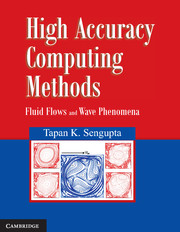Book contents
- Frontmatter
- Contents
- Foreward
- Preface
- Chapter 1 Basic Ideas of Scientific Computing
- Chapter 2 Governing Equations in Fluid Mechanics
- Chapter 3 Classification of Quasi-Linear Partial Differential Equations
- Chapter 4 Waves and Space–Time Dependence in Computing
- Chapter 5 Spatial and Temporal Discretizations of Partial Differential Equations
- Chapter 6 Solution Methods for Parabolic Partial Differential Equations
- Chapter 7 Solution Methods for Elliptic Partial Differential Equations
- Chapter 8 Solution of Hyperbolic PDEs: Signal and Error Propagation
- Chapter 9 Curvilinear Coordinate and Grid Generation
- Chapter 10 Spectral Analysis of Numerical Schemes and Aliasing Error
- Chapter 11 Higher Accuracy Methods
- Chapter 12 Introduction to Finite Volume and Finite Element Methods
- Chapter 13 Solution of Navier–Stokes Equation
- Chapter 14 Recent Developments in Discrete Finite Difference Computing
- Exercises
- References
- Index
Chapter 3 - Classification of Quasi-Linear Partial Differential Equations
Published online by Cambridge University Press: 05 January 2014
- Frontmatter
- Contents
- Foreward
- Preface
- Chapter 1 Basic Ideas of Scientific Computing
- Chapter 2 Governing Equations in Fluid Mechanics
- Chapter 3 Classification of Quasi-Linear Partial Differential Equations
- Chapter 4 Waves and Space–Time Dependence in Computing
- Chapter 5 Spatial and Temporal Discretizations of Partial Differential Equations
- Chapter 6 Solution Methods for Parabolic Partial Differential Equations
- Chapter 7 Solution Methods for Elliptic Partial Differential Equations
- Chapter 8 Solution of Hyperbolic PDEs: Signal and Error Propagation
- Chapter 9 Curvilinear Coordinate and Grid Generation
- Chapter 10 Spectral Analysis of Numerical Schemes and Aliasing Error
- Chapter 11 Higher Accuracy Methods
- Chapter 12 Introduction to Finite Volume and Finite Element Methods
- Chapter 13 Solution of Navier–Stokes Equation
- Chapter 14 Recent Developments in Discrete Finite Difference Computing
- Exercises
- References
- Index
Summary
Introduction
In Chapter 2, we have derived most general form of conservation laws which are solved in CFD. For continuum flows, these are given by Navier-Stokes equation. A quick look at them will show that these are non-linear partial differential equations. To be more precise, they are linear with respect to the highest derivative terms and such equations are called quasi-linear PDEs. It is possible to classify such equations based on the behavior of their solutions. In this chapter, we classify quasilinear PDEs, so that we can derive specific numerical methods for each equation Type in subsequent chapters. Despite the observation that different numerical methods are chosen for different classes of PDEs, we will also see here and in later chapters, that there is a generality of approach in treating these PDEs, whose solution and error propagate in time in a unified manner. This will be clearly evident even for time-independent problems, which are solved iteratively, as will be demonstrated through an example in Section 3.3.
Classification of Partial Differential Equations
Consider the moving boundary problem as shown below. This class of problems is also known as the propagation problem.
Information
- Type
- Chapter
- Information
- High Accuracy Computing MethodsFluid Flows and Wave Phenomena, pp. 31 - 37Publisher: Cambridge University PressPrint publication year: 2013
